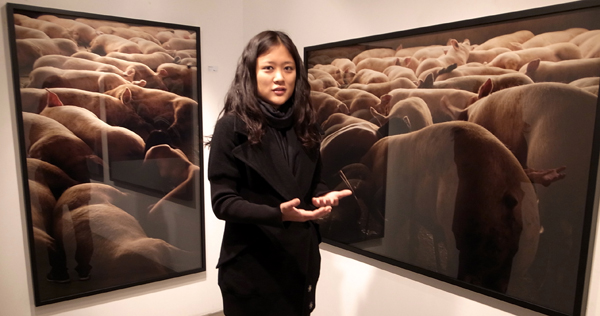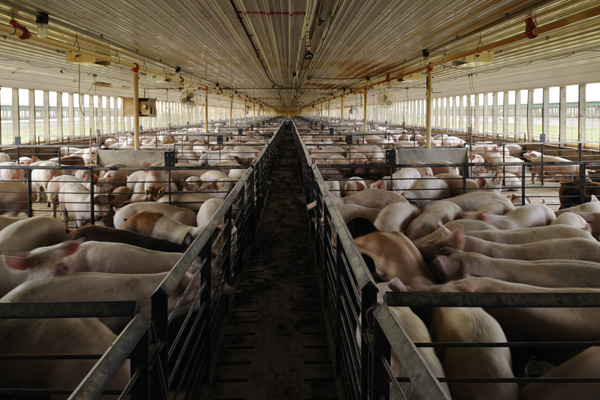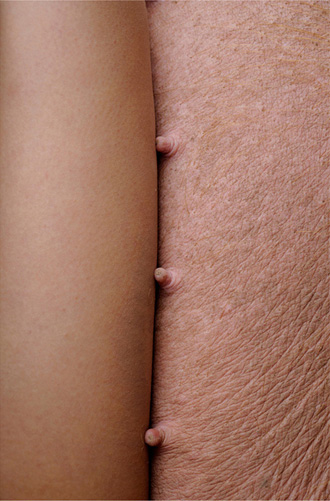Porcine photos with a human voice

New York-based Korean artist Miru Kim talks about her photographs at Trunk Gallery in the art zone east of Gyeongbok Palace in central Seoul, where her solo exhibition “The Pig That Therefore I Am” is currently on display.By Moon So-young
Miru Kim, a New York-based Korean artist now holding a solo show in Seoul, is well known to the general public here, though she is just 31.
That is because many people here have been shocked by her nude photographs of herself in abandoned places, which are part of the 2008 series “Naked City Spleen,” and in particular, her latest photos of herself standing in the nude among caged hogs at industrial farms.
The latter series of photos was exhibited in a New York show titled “The Pig That Therefore I Am” last year and is being exhibited in a show of the same title at Trunk Gallery in the art zone east of Gyeongbok Palace in central Seoul until April 30.
Her renown stems partially from the fact that she is one of the daughters of Do-ol (Kim Young-oak), a famous Korean scholar specializing in Eastern philosophy who appears frequently in the media, and because of the nudity in her works. As an artist, she has been featured by many media outlets, even those that are indifferent to fine art, making her the talk of the town.

Miru Kim’s 2010 photographs “IA 2,” and “Composition 1,” attempt to show the similarities between humans and pigs. The images are part of her solo show at Trunk Gallery in central Seoul, which runs to April 30. Provided by the gallery
Some people regret that her work as an artist is undervalued here due to the sensational approach to her art, while others say that she has become famous thanks to her father.
“That’s one of the reasons why I am based in New York,” Kim said in an interview with the Korea JoongAng Daily at the gallery last week. “Nobody cares whose daughter I am there. I’m used to being independent.”
Her photos, hung on the walls of the small gallery, have the power to make viewers, including those who don’t know her background, stop and stare, whether the reaction is one of puzzlement or one of disgust.

“Composition 1”
“When I dissected a pig in a laboratory class in college, it was the first time that I’d interacted with a pig,” she said. “The class showed human anatomy through porcine anatomy, as they are so similar. I learned that pigs’ digestive systems have more in common with those of humans than with those of other animals. It is even possible for the organs of pigs to be transplanted to humans.”
“The idea was shocking to me,” she continued. “I started to think about what animals are and what humans are and how fragile the boundaries between us are.”
She explained that the title “The Pig That Therefore I Am” comes from “The Animal That Therefore I Am” by Jacques Derrida. The French philosopher raised questions about humans’ superiority over animals, which had been explored by preceding philosophers including Rene Descartes, who said “I think, therefor I am.”
Kim said she was also surprised to learn that 99 percent of the pigs used for pork are raised on industrial farms, where hundreds of pigs are crammed together in small spaces. This method results in near-toxic smells that she had to endure while shooting the photographs, she said.
“Just imagine if people were crammed in this way,” she said. “Their smells would be even worse than those of the pigs and they would probably kill each other.”
“I think about how the relationship between humans and animals, especially those raised for food, has changed in the last centuries,” she said. “I have some nostalgia for old-fashioned farming methods, in which people and animals coexisted and people respected animals.”
But she also said her works are not directly related to the animal rights movement.
Asked how she tolerated the toxic animal smells and what she thought about while she was shooting the photographs, she said, “At those moments, I was not thinking, in fact. I couldn’t afford to frown at the smells. I was just looking at the pigs’ eyes and listening to the noises that they made, to know whether they were angry or just curious.
“I was paying attention to them partly to protect myself. They can turn aggressive and the only way to protect myself was to be communicating with them on the same level.”
“But after I was done with the shoot, I couldn’t endure the smells,” she said, laughing. “I poured vinegar on myself and even tried toothpaste and hydrogen peroxide and everything. But it stayed for three days.”
“But pigs in natural state don’t smell at all,” she emphasized. “Their smells were created by humans.”
By Moon So-young [symoon@joongang.co.kr]
* The show runs through April 30. Admission is free. Hours are 11 a.m. to 7 p.m. Mondays to Saturdays. Go to Anguk Station, line No. 3, exit 1. For more information, visit www.trunkgallery.com or call (02) 3210-1233.










with the Korea JoongAng Daily
To write comments, please log in to one of the accounts.
Standards Board Policy (0/250자)